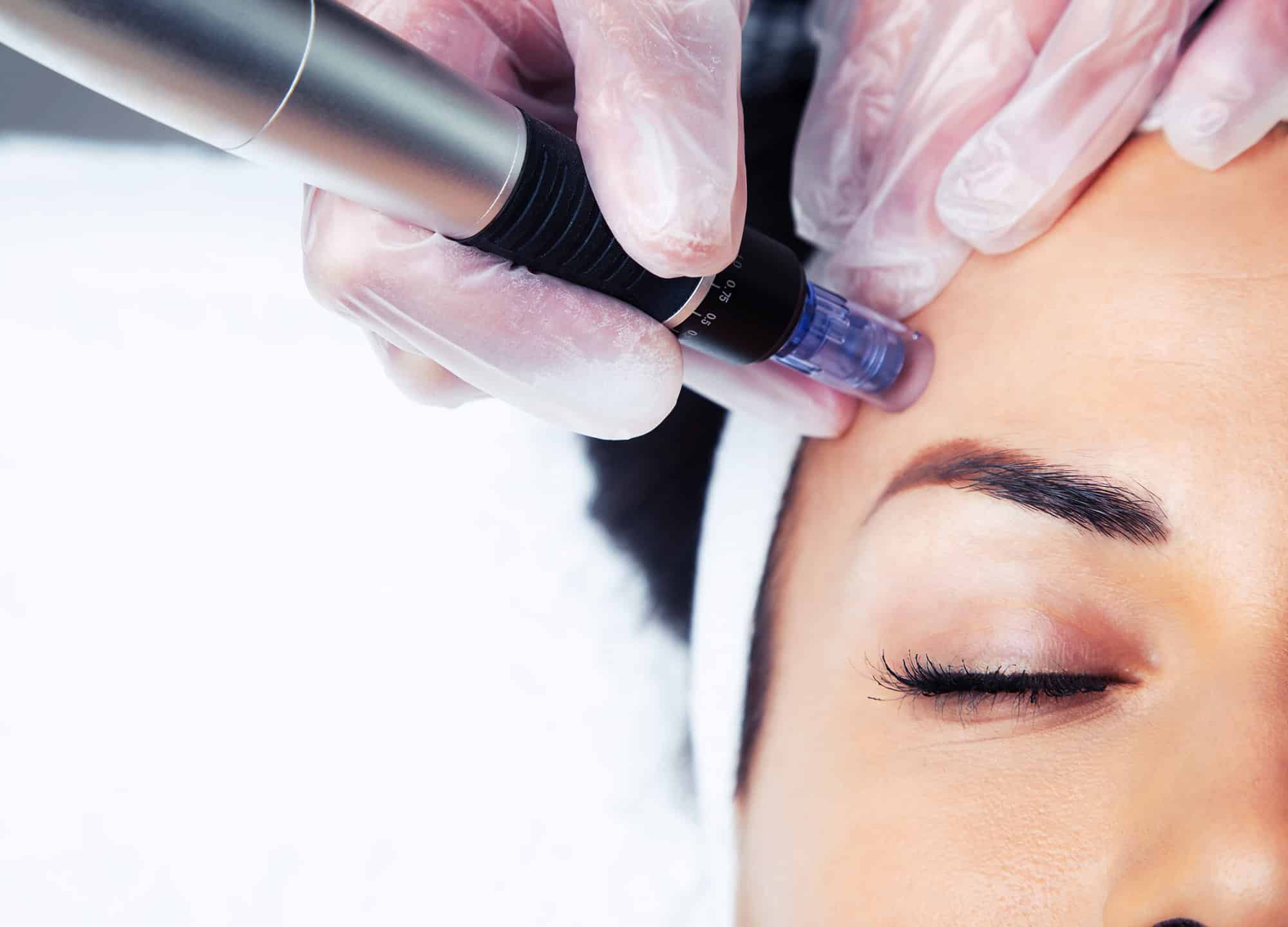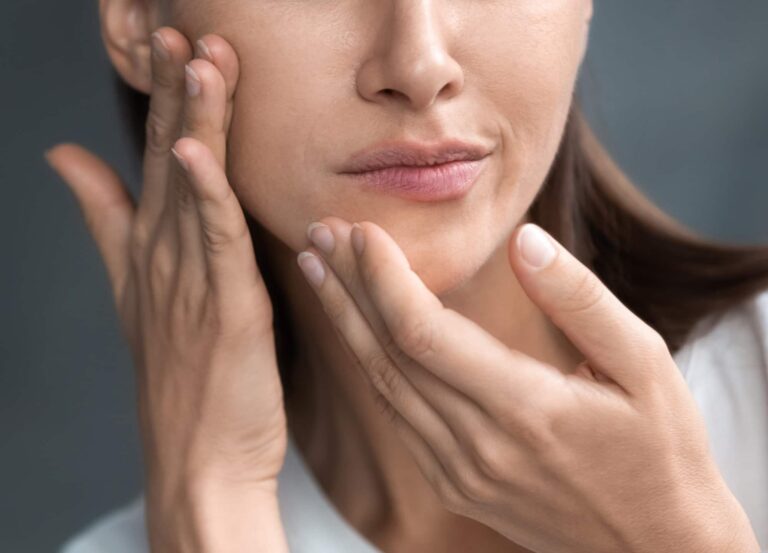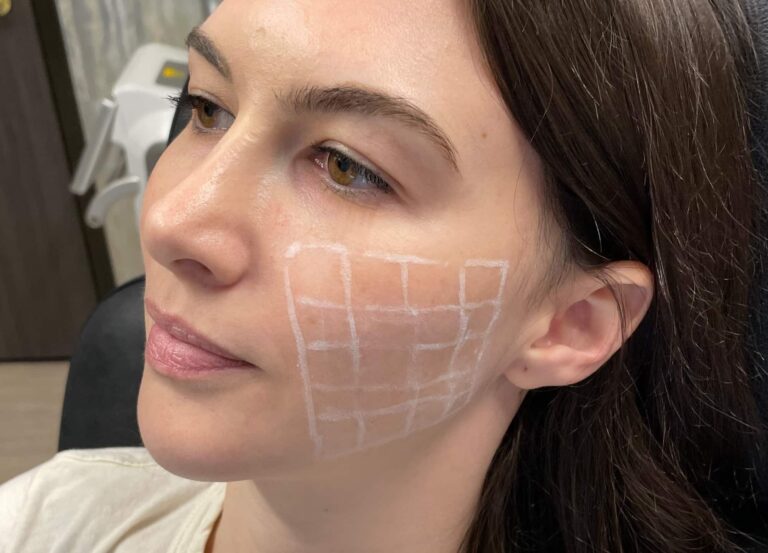This article has been reviewed for medical accuracy by New York board-certified dermatologist Dr. Michele Green on September 2, 2020.
You can exercise like a fiend and bathe in the most expensive anti-aging products, but for many people, the solution to loose skin can be found only in the doctor’s office. Thankfully, there are both noninvasive and surgical treatments to improve dermal laxity—whether your case is mild, moderate, or severe. We asked two experts to break down all your in-office skin tightening options and what procedures work best for different types and severities of laxity.
What exactly is skin laxity?
In the simplest of terms, skin laxity is used to describe the state of loose skin. According to New York City dermatologist Dr. Amy Lewis, it occurs from the loss of collagen and elastin. “Collagen is the main structural and most abundant protein in the body. It is known as the building block of the skin,” she explains. The bad news? In our 20s, collagen production begins to decline 1% each year. On top of that, we also begin to lose elastin. “Elastin is a protein that coils and recoils like a spring within the elastic fibers, accounting for the ‘bounce-back’ effect after the skin is stretched,” Dr. Lewis says. For a visual comparison of how collagen and elastin work, Dr. Lewis says to imagine those Slinky toys you used to play with as a kid. “The integrity of the metal circles would represent the collagen network, whereas its ability to snap back to the original tight form would be due to the elastin,” she says. By losing collagen and elastin as we age, poor lifestyle choices, and simple genetics, our skin continues to sag. Luckily, through volume replacement with dermal fillers and skin tightening lasers, there are non-invasive treatments to help rejuvenate your skin.
What causes skin laxity?
As people get older, it’s common to experience drastic changes to the skin. Wrinkles and fine lines are one thing, but there’s also the issue of sagging skin. While age is a big cause of skin laxity, there are several other contributors as well. “Genetics, sun exposure, diet, lifestyle, stress, and smoking are the most common culprits,” Dr. Lewis says. However, she also points out that how well the skin might age, or not, can depend on multiple other factors. “Aside from the hereditary biological clock, lifestyle habits, food and beverage choices, hydration, and exposure to sunlight or reactive chemicals contribute to the longevity and tautness of the skin,” she says. “Other causes include significant weight loss, repetitive facial movements, chronic unmanaged stress, and the effects of gravity.”
Patients who have had serious illnesses, whether it be metabolic, cancer, or stress related, are also likely to experience increased laxity.
Dr. Jason Emer, a board-certified dermatologic surgeon in West Hollywood, California, says that skin laxity really boils down to the genetic lottery. “Some people just sag more as they get older, while earlier sagging can be from hormonal changes, like having children, or weight fluctuations in people [who] are yo-yo dieters or marathon runners,” he says. While there’s not much you can really do when it comes to your genetic predisposition, you can avoid smoking, stay out of the sun, and eat a diet rich in antioxidants—these can help fight against the damage caused by free radicals. “If measures are taken to reduce degradation and improve production of collagen and elastin, laxity of the skin can be slowed or partially reversed,” says Dr. Lewis.
The different types of skin laxity
The levels of laxity can be split into three categories: mild, moderate, and severe. “Mild is when you start to see it a little bit in the jowls, maybe [the] midface, but there isn’t much dissent in the neck,” explains Dr. Emer. “Then, as you go to moderate and severe, you’re going to see the neck hanging a little bit more with crepiness, jowls starting to form in the downturning of the mouth, and the muscles in the neck will start to become more apparent.” When somebody has lost the architecture of their neck or has a significant amount of loose skin, they typically become a candidate for surgery, Dr. Emer says.
In the past, he says, a lot of patients would request fillers from their doctors to treat their skin laxity. The result was looking overdone or disproportionate, since doctors didn’t have a lot of options to lift the skin without surgery. Then came radiofrequency treatments. The problem with these, Dr. Emer says, is that they often last for only a couple of weeks before the skin goes back down. “It’s like a workout for the skin; if you don’t keep doing it, you don’t maintain the results or prevent sagging. You have to do other things that are going to either lift the tissue or contract the tissue.” Now there are more efficient noninvasive ways to treat laxity, like ultrasound and microneedling radiofrequency procedures.
Treatments for mild laxity
If you have mild laxity and are dealing with minor neck jowling, Thermage or Ultherapy are “tried and true skin tightening procedures,” according to Dr. Emer. Thermage is a type of radiofrequency treatment, but it utilizes high energy and can be done once or twice a year, he says. One of the benefits of Thermage, especially the new Theramage FLX, is that it can be used to treat skin laxity on any area of the body, including the upper arms, thighs, abdomen, and buttocks.
Ultherapy uses ultrasound to create thermal heat under the surface of the skin, which works to tighten. There are also microneedling radiofrequency treatments, like Fractora and Morpheus, which are excellent at creating new collagen to help tighten skin. Fraxel and eMatrix lasers are terrific at providing new collagen through fractionated technology and radiofrequency heat.
“I always [recommend the treatments] that are the least painful and have noticeable results, and [patients] tell me that’s Fractora or Morpheus,” says Dr. Emer. You can also use both of these on body areas that have crepey skin, like the knees, elbows, or chest. They can even be used for vaginal tightening. Fractora and Morpheus can be done every two to three months and combined with Thermage or Ultherapy, which are typically done once or twice a year. “It’s done in combination because you have to address the underlying tissue, the muscle, and the texture,” Dr. Emer says, pointing out that over time, noninvasive treatments can end up costing more than surgery. Still, if you don’t want to worry about a lengthy downtime, these are good options. Otherwise, some patients will opt for a mini facelift, to treat mild skin laxity of the neck and jowls.
Another newer, noninvasive option is threading. Threading consists of internal sutures, inserted into the skin through a small puncture, which end up lifting the tissue and tightening skin. The results are visible immediately; over time, the stitches dissolve underneath the skin and help boost collagen production. Silhouette InstaLift uses threads made from resorbable sutures and sugar-based cones and can last up to a year. PDO NovaThreads is another option that lasts from 6 to 12 months.
Related: The Little-Known Eye Lift Procedure That’s Taking Over Hollywood
Treatments for moderate laxity
For patients who are further along in skin laxity but still don’t want surgery, minimally invasive, heat-based treatments such as ThermiRF, FaceTite, or Renuvion may be helpful. ThermiRF creates a small puncture through which to heat the tissue underneath the skin. This can result in a “pseudo neck lift,” Dr. Emer explains, saying that he’s also had patients do it on their bra roll or on their knees. FaceTite delivers electrical energy through a probe, and Renuvion uses helium-derived plasma and radiofrequency energy. While all of these treatments are very effective, they must be performed by an experienced doctor, since there is a risk of burning through the skin. The results of these internal heating procedures last longer (about two to three years), with minimal downtime compared to a more invasive surgical procedure. “It will never replace a neck lift, but you’ll get about 20% or 30% of a neck lift in one treatment,” Dr. Emer says. Sometimes these treatments are done in combination with liposuction.
Treatments for severe laxity
Though nonsurgical devices can be used on the body, they likely will not provide the desired results on significant laxity caused by childbirth or major weight loss. In those cases, a tummy tuck or a lift (be it of the arms, breasts, or thighs) is really the best option. The same goes for the face, but if you are going to get a facelift, it’s important to “protect your investment through maintenance,” says Dr. Emer. “Even if you get a $30,000 facelift and it’s great, every three months after that, you’ve got to do [a treatment like] Morpheus. And once a year, you have to do a Thermage or Ultherapy session. You want to maintain it, otherwise you go back to the normal aging process.”











